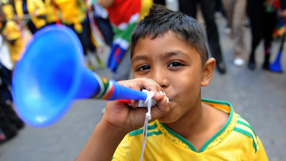Vuvuzela inventor: No sin to make a din
CAPE TOWN - When choosing a vuvuzela at the World Cup you put your money where your mouth is.

The ubiquitous plastic trumpet, embraced as an emblem of the World Cup by South Africans and visitors alike, sells for between 20 rand ($2.6) for a simple Chinese import to 60 rand for a more contoured instrument, produced in South Africa.
"Our vuvuzelas have the purest sound and they are the easiest to blow. A two-year-old could play it," said Cape Town-based Neil van Schalkwyk, who developed the vuvuzela seven years ago and whose sales have grown from 500 a month to 50,000.
"Our vuvuzelas also have a much more comfortable mouth-piece. I think at the end of the World Cup we'll see a lot of people with cut, sore lips," he added.
Watching the horn sold everywhere from street corners to airport duty free shops and listening to the cacophony of vuvuzela blasts ringing out through the city, Van Schalkwyk, a plastics expert and mould maker, says he feels very proud.
With a background in toolmaking, the 37-year-old football fan watched people taking home-made tin horns to games in the 1990s and decided to try producing his own in plastic.
Van Schalkwyk initially named his horn the boogie-blaster, but fans dubbed it the vuvuzela - which means 'pump' or 'lift up' - and the fad was born.
Today the vuvuzela industry is worth 50 million rand ($6.45 million) in South Africa and Europe, he estimates. He declined to say how much he had made from his invention.
Get FourFourTwo Newsletter
The best features, fun and footballing quizzes, straight to your inbox every week.
"The vuvuzela is a symbol of the way we can celebrate and how we would like the rest of the world to enjoy their celebrations as well."
The fact it has been much copied does not irk him, he says.
"We were never under the illusion we'd have a monopoly on the product and we couldn't patent the design. When we started out we were told a horn is a horn and it has been around for centuries!"
Horns have always played a part in South African culture, from the earliest kudu horns, traditionally used to announce a ceremony or a major event.
The latest version of the horn is made from three pieces of injection-moulded plastic, and the mouthpiece has been modified to reduce the noise level by 20 decibels, a concession to those who have complained about the din generated by vuvuzelas.
"They have become so popular, it has surpassed my wildest expectations," said Van Schalkwyk.
